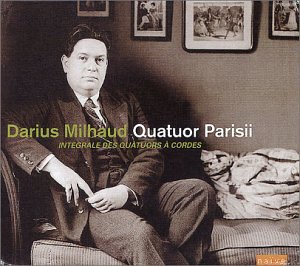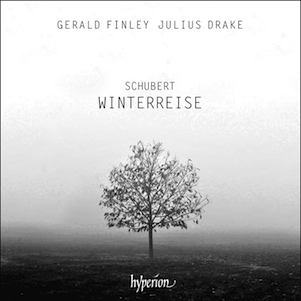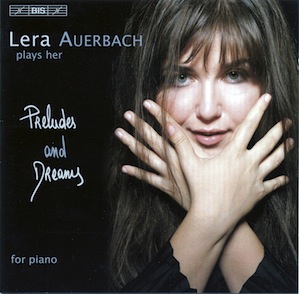Coming soon, shortly, or perhaps as soon as I can get to it:

After several years of looking, I tracked down this integral (5 disc) set. the effort was worth it. There is a lot to write and report because I have been unable to find a comprehensive review of the set.

If you feel that you have been waiting 50 or 60 years for a new king of the Winterreise to be crowned, this could be your recording. It is available as a 96/24 download from Hyperion Records for £12.00.

Preludes and Dreams
written and performed by Lera Auerbach.
Contents:
Cycling through the 24 keys by means of a series of short pieces is an old tradition, more or less headed by J. S. Bach's twin efforts known as Book I and Book II of Das Wohltemperierte Klavier as well as his two and three part inventions. Many other composers have followed, and the well worn path continued through the 20th century, notably with Shostakovich's 24 Preludes of 1933 and the later 24 Preludes and Fugues of 1951. [ I admit a personal fondness for Nikolai Kapustin's 24 Preludes in Jazz Style of 1988. ]
The 24 Preludes for Piano, Op. 41 by Lera Auerbach date from the very close of the 20th century, 1999, as do the Ten Dreams, Op 45. The final piece is listed as Chorale, Fugue, and Postlude, Op 31, and it is given the dates '1994 / 2003', which I take to mean it has been revised.
A bit of bad news
I have a few hundred recordings by BIS, and almost all have very good liner notes that contribute to one's understanding of music that is often unfamiliar and new. BIS has recorded a number of modern composers, and providing badly needed background information is one of their strengths.
Not so in this case. Included is a short essay by Axel Brüggemann, and the essay only mentions the 24 Preludes. It spends most of its two plus pages eulogizing the composer. An essay of similar size, uncredited, provides a biography of Auerbach's accomplishments and some of her performance history.
A disappointment, but it gives me something to research.
A lot of good news
This recording is a must buy for those of us who are curious where traditional forms of music are headed in the 21st century. It is always a little risky to review a first recording of music performed by the composer; after all, who is to say that it is not being performed as she intended? And I don't have the score. But because this music is so immediately and obviously 'good,' there is less risk of my making a fool of myself in this review.
24 Preludes
The 24 Preludes are presented in circle-of-fifths order, and occupy 45:22 of the slightly-more-than-allowed-by-CD-spec 80:05 total playing time. The first listen will convince you that this is the intended order, something like the carefully worked out presentation of the Mörike Songs by Hugo Wolf, or Winterreise by Schubert.
I say this because the final prelude (D minor) is easily the longest in the set, running 5:30, more than two minutes longer than the second place (G major), even accounting for the fact that it ends with fifteen seconds of silence after the final note dies away. The final prelude revisits phrases from several of the earlier ones, discards them, and generally thrashes about the way that, say, the finale of Anton Bruckner's 5th Symphony or Beethoven's 9th Symphony revists music from their previous movements. The novel element, a motif that sounds like it belongs to a berceuse, is never quite able to battle back the dæmons of the previous 23 pieces.
Now suppose you are, by now, kind of interested in this music because of your reading of this review, but not ready to part with the $20 or so that a new copy will cost you. You may buy them 'by the each' on iTunes or Amazon, but which one to buy? The most interesting one to me, as well as the most representative of what I think Auerbach may be trying to say with this music, is #9 (E major). My wife, who does play this type of music, concurs.
This sub-one-minute anti-waltz is a fine example of the craft of the
entire set. The initial idea is presented, almost immediately begins to
transform, and at the fifteen second mark a second theme emerges. The
battle between the two reaches an unsatisfying cease fire at 0:42,
and there is a very brief wrapup in the form of
Other notable elements in the set are #12 (G sharp minor), #14 (E flat minor), and #23 (F major). Almost any example is interesting by itself, but it is hard to come up with a list of greatest hits because of the way they interlock.
Several people have compared Auerbach's music to Schnittke's, but the 24 Preludes also have much in common with Schoenberg's piano miniatures of Op. 19, Op. 23, and Op. 25.
Ten Dreams
The first of the Ten Dreams is subtitled 'As In A Nightmare.' It is hard to imagine how it is much different from the nine that follow as far as its declared resemblance. This is some very dark and disturbing music.
It is pure coincidence that my first hearing was at about 2AM via headphones in a dark room. What a journey in darkness and through darkness was my inaugural listen. These short works could each be the soundtrack for any of the movies on this list: Eraserhead, Dark City, Antichrist, A Clockwork Orange. The Ten Dreams are each and all less structured than the 24 Preludes, but similar in sound, and I can't help wondering if they may have begun their lives in the other pile, only to be rejected into the newer collection.
A word of warning: Dream #10 must be just before waking up. It will send you to the volume control, and I suspect it (and several of the other pieces) caused an emergency retuning of the D-series Steinway before the recording session was completed.
Chorale, Fugue, and Postlude
After the ordeal of sleeplessness brought about by the very active dreaming, Chorale, Fugue, and Postlude is something of a break for the ears and the exhausted emotions. Well, at least the Chorale and the Fugue are such. The Postlude is another postlude to life itself, perhaps saying as Eliot does in the last line of East Coker, " in my end is my beginning."
Lera Auerbach's Music
Less than a year ago, I had not heard of Lera Auerbach. A number of people are trying to find a pigeon hole into which she fits: Ex-pat from the old USSR (although she was only a teenager when she 'defected.'). More like Schnittke and Gubaidulina than Shostakovich and Shchedrin. And like many women in legit music, there are Internet opinions offered about whether she is or is not 'attractive.'
So far, this is all I have heard of her work, and it is necessary to not draw too many conclusions from one CD of examples. However, while her sound world is somewhat akin to Schnittke's Peer Gynt of the late 1980s, it lacks completely the element of pastiche found in a substantial amount of his work. Also missing are the polystylistic elements that are not pastiche --- in other words, Auerbach's voice and style seem to be truly her own.
The playing
Auerbach has excellent technique; a lot of the music sounds quite hard to play. From the cover photo, her hands do not appear to be of Lisztian proportions, but hand size is hardly a requirement for superb abilities. Consider Leopold Godowsky, author of some of the most difficult piano music written before 1950, and he is said to have had small hands that could still play his own works. [ In fact, her hands look small. For a gender and age appropriate comparison, look at the above cover photo, and compare to this photo of Ragna Schirmer. ]
Auerbach, or is it Auerbach's music?, stresses the piano. While listening for what iTunes says was my seventh time, I found myself wondering if during a live performance the bottom two octaves would require some mid-concert work, particularly before the maximally abusive D minor finale. Although this is a RBCD not an SACD, the sound is just fine.
I hope that Marc-André Hamelin will attempt a few of these pieces, perhaps as fillers on an upcoming album.
Bottom line
This is some great stuff. I wish I could find out more about the music, and what Auerbach intended, but like a lot of res ipsa loquitur 'good' music, it really does speak for itself.

Années De Pèlerinage
by Franz Liszt, performed by Ragna Schirmer.
This three disc set is Ragna Schirmer's most recent recording, and it was released on October 11, 2011 in the United States. Certainly, this could become regarded as the definitive performance of Années De Pèlerinage, or Years of Pilgrimage. It is well recorded, complete, and interestingly presented as a concept album with somewhat related madrigals.
The Music:
Years of Pilgrimage is a set of three collections of solo piano pieces by Franz Liszt. They were published in 1855, 1858, and 1877, but like all of Liszt's works they have their beginnings as early as the mid-1830s, with various versions existing in different stages of being entirely finished. As you might guess from the dates, the third volume ("Third Year") is a different experience from the first two. Any complete presentation, including this one, usually includes three pieces known as "Venice and Naples" that date from the 1850s.
The collection includes well known pieces, such as "Après une lecture du Dante" (a.k.a., the Dante Sonata) and "Au lac de Wallenstadt," that are sometimes performed separately (and often). As a whole, it includes a little less than two and a half hours of piano music that form an emotional journey through life and times as well as the places that inspired each piece.
Schirmer's recording is divided across three CDs, one for each year, and includes eight madrigals by Gesualdo and Marenzio interspersed just before the pieces to which they pertain, much as the chorus in a Greek play comments on the action. Schirmer has been doing these "concept albums" for a while now, presenting pieces of music that are related to each other, and yet contrast.
The performance:
First, let's discuss the madrigals performed by Amarcord. The eight are uniformly excellent, and I will be purchasing other recordings by this small ensemble. The voices are presented up front, but without a trace of the off-sounds produced by the microphone's proximity. In short, there is nothing much to say beyond, "This is as good as it gets."
Schirmer shares with Glenn Gould the ability to clarify lines of music in complex pieces that are always on the verge of becoming musical noise in the hands of less skilled performers. And she does not sing along. This makes her particularly suited to music that, even when quiet or slow, can have several things going on at once.
Some of the highlights in this performance are Year One's "Orage" and "Le Mal Du Pays," two very different works; Year Two's Sonnets of Petrarch; and the two pieces named "Thrénodie" in Year Three.
For comparison on all the pieces, I turned to Leslie Howard's performances on Volumes 39, 43, and 12 of his Liszt marathon late in the previous century. As a set, the Schirmer performance has much more unity, and I can't help but wonder if this unity comes from recording it all at once, at the same point in her career as a pianist, where Howard recorded his set over a period of five years during which he recorded thirty five hours of Liszt's other music? Schirmer has a generally lighter touch with the fast and dense parts, and that considerably assists with their appreciation by me.
Of course, the more popular works have a lot of other recordings to choose from. Hélène Grimaud recorded the Dante Sonata on her debut album, and it is a particularly fine performance of a showpiece. Horowitz loved Liszt, and while the performances are good, the recordings that I have are so bad that the sound conflicts with my enjoyment. Hough's recording of Year 1 on Hyperion is a fine one, and there are budget sets with Jenö Jandó on Naxos, as well as reissues from the later part of the analog era.
If you are only going to have one set, and particularly if the music is new to you, I recommend Schirmer.
The recording:
I discovered Schirmer while reading Fanfare Magazine a couple of years ago in which her recording of Händel's Keyboard Suites was mentioned in passing as being preferred to the disc under review. I bought it. I believe it may have been the first disc I purchased on Berlin Classics.
Like her other discs, this one is well recorded, with the microphones seemingly placed a little higher than usual above the piano. This placement (whatever it is in fact) produces a more natural sound when listening on headphones, while doing nothing bad to the sound when listening through the usual front speakers.
Whatever compression there is in the recording process is judiciously applied, and there are no artifacts at all -- the recording could easily pass for an SACD issue. The venue is not identified, but it is quiet: no planes, trains, or automobiles to be heard. Additionally, Schirmer is apparently able to play without breathing, or at least she makes no noise while doing so. Even the pedaling is quiet.
The liner notes:
Another beautifully produced and printed, but awkward release from Berlin Classics. The cardboard folds out twice, with three discs in a row to the left, and the liner notes glued to the fourth position. It is difficult to read the text. The booklet contains information (apparently written in part by Schirmer) about the pieces, and several strange photos of the back of Schirmer's head as she gazes toward the object of interest along with us, and photos that are too small (about the size of a postage stamp) to really be seen. I am sure it must have looked good before it was printed, still in the publishing software on a monitor that was 2560 pixels across.
The English is easy to find, with a little bit on each page, and it says the same thing as the German does, unlike albums where there are different write-ups for each language.

